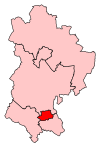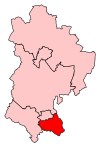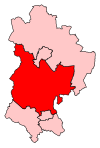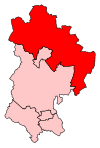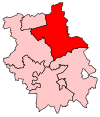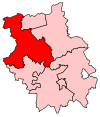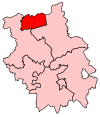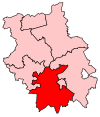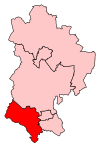The region[1] of the East of England is divided into 58 parliamentary constituencies which is made up of 16 borough constituencies and 42 county constituencies. Since the general election of December 2019,[2] 51 are represented by Conservative MPs, six by Labour MPs, and one by a Liberal Democrat MP.
YouTube Encyclopedic
-
1/5Views:6 929 427154 791508 510488 8081 043 481
-
Why the UK Election Results are the Worst in History.
-
Will The North of England Become An Independent Country in 2021?
-
King George V - Founder of the House of Windsor Documentary
-
Scotland: Is the desire for independence growing? | DW Documentary
-
Which voting system is the best? - Alex Gendler
Transcription
Hello Internet The UK had an election we need to talk about because after the debates finished, the people voted and the ballots tallied the results were this: But parliament ended up looking like this: Which isn't, exactly, representative. And by not exactly, I mean at all. Red earned 30% of the vote and 36% of the seats, which is sort of close, but the rest is madness: Orange earned 8% of the vote but got one eighth of that while Yellow's 5% just about doubled, and purple earned 13% and got squat. Meanwhile blue's 37% of the people booted to 51% of the seats in parliament. The blue boost is even bigger when you consider that 51% of the seats gives basically 100% the control. How'd this happen? In the UK -- national elections aren't really national, they're a bunch of local elections. The UK is divided into constituencies, each of which elects one member of parliament (M.P.) to represent them. This local / national divide is where the trouble begins. Imagine a parliament with just three constituencies, and it's easy to see how it wouldn't always align with citizens. Some people think this sort of result is fine -- “it's all *about* winning local elections,” they’ll say. “Each M.P. represents their constituency.” And while the imbalance in this example is dumb, but it's the same problem in the real election and this same argument is given, but there are two more problems with it in reality land. 1) Few citizens have any idea who their MP is, they just know what party they voted for -- what party they want to represent their views on the national level. And pretending like it's a local election is a bit disingenuous. -- in practice it's an election for now the nation will run -- not really for who is going to represent a tiny part of it. and even if it were 2) The individual constituencies are worse at representing their citizens than parliament. Indulge this spreadsheet-loving nerd for a moment, will you? The difference between what a party earned at the polls and what they got in parliament is the amount of misrepresentation error. If we calculate all the errors for all the parties and add them up we can say the Parliament as a whole has 47% percentage points of misrepresentation error. That sounds bad looks like a utopian rainbow of diversity compared to any local election because the local elections have *one* winner. Out of the 650 constituencies 647 have a higher representation error than parliament. These are the only three that don't and they're really unusual for having so many of a single kind of voter in one place. Most places look the The Wrekin which is dead in the middle a mere one-hundred and one points off. Note that the winning candidate didn't reach a majority here. Which means more than half of constituencies elected their MP with a minority of voters. The worst is Belfast South at the bottom of the list. Hilariously unrepresentative. Less than a quarter of the voters get to speak for the entire place in parliament. This is the the lowest percentage an M.P. has ever been elected by. So when people argue that the UK election is a bunch of local elections 1) people don't act like it, and 2) It's even more of an argument that the elections are broken because they're worse on this level. These local elections are unrepresentative because of the terrible 'First Past the Post' voting system -- which I have complained mightily about and won't repeat everything here -- go watch the video -- but TL;DR it only 'works' when citizens are limited to two choices. Voting for any party except the biggest makes it more likely the biggest will win by a minority -- which is exactly what happened. That citizens keep voting for smaller parties despite knowing the result is against their strategic interests demonstrates the citizenry wants diverse representation -- but that successes is the very thing that's made this the most unrepresentative parliament in the history of the UK. People happy with the results argue the system is working fine -- of course they do. Their team won. Government isn't a sport where a singular 'winner' must be determined. It's a system to make rules that everyone follows and so, we need a system where everyone can agree the process is fair even if the results don't go in their favor. If you support a system that disenfranchises people you don't like and turbo-franchises people you do -- then it doesn't look like you sport representative democracy, it looks like you support a kind of dictatorship light. Where a small group of people (including you) makes the rules for everyone. But as it is now, on election day the more people express what they want the worse the system looks which makes them disengaged at best or angry at worst and GEE I CAN'T IMAGINE WHY. This is fixable, there are many, many better ways the UK could vote -- here are two that even keep local representatives. And fixing voting really matters, because this is a kind of government illegitimacy score -- and it's been going up and may continue to do so unless this fundamentally broken voting system is changed.
Constituencies
† Conservative ‡ Labour ¤ Liberal Democrat # Independent
Proposed boundary changes
See 2023 Periodic Review of Westminster constituencies for further details.
Following the abandonment of the Sixth Periodic Review (the 2018 review), the Boundary Commission for England formally launched the 2023 Review on 5 January 2021. The Commission calculated that the number of seats to be allocated to the Eastern region will increase by 3, from 58 to 61.[7] Initial proposals were published on 8 June 2021 and, following two periods of public consultation, revised proposals were published on 8 November 2022. The final proposals were published on 28 June 2023.
Under the final proposals, the following constituencies for the region will come into effect at the next general election:[8]
| Constituency | Electorate | Ceremonial county | Local authority |
|---|---|---|---|
| Basildon and Billericay BC | 76,993 | Essex | Basildon |
| Bedford BC | 70,068 | Bedfordshire | Bedford |
| Braintree CC | 75,662 | Essex | Braintree / Uttlesford |
| Brentwood and Ongar CC | 74,937 | Essex | Brentwood / Epping Forest |
| Broadland and Fakenham CC | 72,907 | Norfolk | Breckland / Broadland |
| Broxbourne BC | 75,454 | Hertfordshire | Broxbourne / East Hertfordshire |
| Bury St Edmunds and Stowmarket CC | 75,655 | Suffolk | Mid Suffolk / West Suffolk |
| Cambridge BC | 72,560 | Cambridgeshire | Cambridge |
| Castle Point BC | 70,923 | Essex | Castle Point / Basildon |
| Central Suffolk and North Ipswich CC | 71,020 | Suffolk | East Suffolk / Ipswich / Mid Suffolk |
| Chelmsford BC | 76,454 | Essex | Chelmsford |
| Clacton CC | 75,959 | Essex | Tendring |
| Colchester BC | 76,843 | Essex | Colchester |
| Dunstable and Leighton Buzzard CC | 74,069 | Bedfordshire | Central Bedfordshire |
| Ely and East Cambridgeshire CC | 76,279 | Cambridgeshire | East Cambridgeshire / South Cambridgeshire |
| Epping Forest CC | 74,553 | Essex | Epping Forest |
| Great Yarmouth CC | 70,077 | Norfolk | Great Yarmouth |
| Harlow CC | 73,479 | Essex | Epping Forest / Harlow / Uttlesford |
| Harpenden and Berkhamsted CC | 71,635 | Hertfordshire | Dacorum / St Albans |
| Harwich and North Essex CC | 74,838 | Essex | Colchester / Tendring |
| Hemel Hempstead CC | 70,496 | Hertfordshire | Dacorum |
| Hertford and Stortford CC | 75,396 | Hertfordshire | East Hertfordshire |
| Hertsmere CC | 73,256 | Hertfordshire | Hertsmere / Welwyn Hatfield |
| Hitchin CC | 72,112 | Bedfordshire / Hertfordshire | Central Bedfordshire / North Hertfordshire |
| Huntingdon CC | 75,590 | Cambridgeshire | Huntingdonshire |
| Ipswich BC | 75,117 | Suffolk | Ipswich |
| Lowestoft CC | 73,967 | Suffolk | East Suffolk |
| Luton North BC | 73,266 | Bedfordshire | Luton |
| Luton South and South Bedfordshire CC | 70,197 | Bedfordshire | Central Bedfordshire / Luton |
| Maldon CC | 76,794 | Essex | Chelmsford / Maldon |
| Mid Bedfordshire CC | 71,748 | Bedfordshire | Bedford / Central Bedfordshire |
| Mid Norfolk CC | 71,060 | Norfolk | Breckland / South Norfolk |
| North Bedfordshire CC | 76,319 | Bedfordshire | Bedford / Central Bedfordshire |
| North East Cambridgeshire CC | 70,806 | Cambridgeshire | Fenland |
| North East Hertfordshire CC | 76,849 | Hertfordshire | East Hertfordshire / North Hertfordshire |
| North Norfolk CC | 70,719 | Norfolk | North Norfolk |
| North West Cambridgeshire CC | 73,556 | Cambridgeshire | Huntingdonshire / Peterborough |
| North West Essex CC | 76,280 | Essex | Chelmsford / Uttlesford |
| North West Norfolk CC | 75,200 | Norfolk | Kings Lynn and West Norfolk |
| Norwich North BC | 71,441 | Norfolk | Broadland / Norwich |
| Norwich South BC | 73,201 | Norfolk | Norwich / South Norfolk |
| Peterborough CC | 72,273 | Cambridgeshire | Peterborough |
| Rayleigh and Wickford CC | 76,422 | Essex | Basildon / Rochford |
| South Basildon and East Thurrock CC | 73,322 | Essex | Basildon / Thurrock |
| South Cambridgeshire CC | 75,484 | Cambridgeshire | Cambridge / South Cambridgeshire |
| South Norfolk CC | 69,837 | Norfolk | South Norfolk |
| South Suffolk CC | 71,070 | Suffolk | Babergh |
| South West Hertfordshire CC | 71,552 | Hertfordshire | Dacorum / Three Rivers |
| South West Norfolk CC | 72,496 | Norfolk | Breckland / Kings Lynn and West Norfolk |
| Southend East and Rochford CC | 70,094 | Essex | Rochford / Southend-on-Sea |
| Southend West and Leigh BC | 76,824 | Essex | Southend-on-Sea |
| St Albans CC | 70,881 | Hertfordshire | St Albans |
| St Neots and Mid Cambridgeshire CC | 74,699 | Cambridgeshire | Huntingdonshire / South Cambridgeshire |
| Stevenage CC | 70,370 | Hertfordshire | East Hertfordshire / North Hertfordshire / Stevenage |
| Suffolk Coastal CC | 72,683 | Suffolk | East Suffolk |
| Thurrock BC | 73,347 | Essex | Thurrock |
| Watford BC | 70,576 | Hertfordshire | Hertsmere / Watford |
| Waveney Valley CC | 70,540 | Norfolk / Suffolk | East Suffolk / Mid Suffolk / South Norfolk |
| Welwyn Hatfield CC | 74,535 | Hertfordshire | Welwyn Hatfield |
| West Suffolk CC | 76,243 | Suffolk | West Suffolk |
| Witham CC | 75,064 | Essex | Braintree / Colchester / Maldon |
Results history
Primary data source: House of Commons research briefing - General election results from 1918 to 2019[9]
2019
The number of votes cast for each political party who fielded candidates in constituencies comprising the East of England region in the 2019 general election were as follows:
| Party | Votes | % | Change from 2017 | Seats | Change from 2017 |
|---|---|---|---|---|---|
| Conservative | 1,754,091 | 57.2% | 52 | ||
| Labour | 749,906 | 24.4% | 5 | ||
| Liberal Democrats | 410,849 | 13.4% | 1 | 0 | |
| Greens | 90,957 | 3.0% | 0 | 0 | |
| Brexit | 11,707 | 0.4% | new | 0 | 0 |
| Others | 50,751 | 1.6% | 0 | 0 | |
| Total | 3,068,261 | 100.0 | 58 |
Percentage votes

Key:
CON - Conservative Party, including National Liberal Party up to 1966
LAB - Labour Party
LIB - Liberal Party up to 1979; SDP-Liberal Alliance 1983 & 1987; Liberal Democrats from 1992
UKIP/Br - UK Independence Party 2010 to 2017 (included in Other up to 2005 and in 2019); Brexit Party in 2019
Green - Green Party of England and Wales (included in Other up to 2005)
Seats

Key: CON - Conservative Party, including National Liberal Party up to 1966
LAB - Labour Party
LIB - Liberal Party up to 1979; SDP-Liberal Alliance 1983 & 1987; Liberal Democrats from 1992
OTH - 1945 - Common Wealth Party (unopposed by Labour); 2015 - UK Independence Party
See also
- List of United Kingdom Parliament constituencies
- List of parliamentary constituencies in Bedfordshire
- List of parliamentary constituencies in Cambridgeshire
- List of parliamentary constituencies in Essex
- List of parliamentary constituencies in Hertfordshire
- List of parliamentary constituencies in Norfolk
- List of parliamentary constituencies in Suffolk
Notes
References
- ^ See NUTS 1 statistical regions of England
- ^ "2019 Election Results". BBC News. 13 December 2019.
- ^ Baker, Carl; Uberoi, Elise; Cracknell, Richard (28 January 2020). "General Election 2019: full results and analysis".
{{cite journal}}: Cite journal requires|journal=(help) - ^ a b c "Constituencies A-Z - Election 2019". BBC News. Retrieved 26 April 2020.
- ^ "Southend West by-election live updates: Residents vote to elect MP after Sir David Amess' death". Essex Live. 4 February 2022. Retrieved 4 February 2022.
The turnout for the Southend West by election was 24.03 per cent of an electorate of 66,354
- ^ "Election results Southend West by-election 2022". 4 February 2022. Retrieved 4 February 2022.
- ^ "2023 Review | Boundary Commission for England". Retrieved 8 January 2021.
- ^ "The 2023 Review of Parliamentary Constituency Boundaries in England – Volume two: Constituency names, designations and composition – Eastern | Boundary Commission for England". boundarycommissionforengland.independent.gov.uk. Retrieved 8 July 2023.
- ^ Watson, Christopher; Uberoi, Elise; Loft, Philip (17 April 2020). "General election results from 1918 to 2019".
{{cite journal}}: Cite journal requires|journal=(help)
























